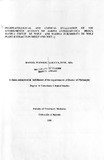| dc.description.abstract | The use of medicinal plants for the control of helminthoses has been in practice for
centuries and there are many plants claimed to have anthelmintic activity. However, it
is only a few of these plants that have their anthelmintic activity scientifically
evaluated. These studies were done to evaluate the anthelmintic activity of Albizia
anthelmintica Brogn, Maerua edulis De Wolf and Maerua subcordata De Wolf in
sheep and mice and to determine the bioactivity of these plants using brine shrimp
lethality test. An attempt was also made to separate the pharmacological active
ingredient in Albizia anthelmintica water extract.
A questionnaire was used to obtain medicinal plants used by farmers and herbalists in
Kibwezi Division of Makueni district and Tunyo division of Marakwet district as
anthelmintic. Out of 51 useful plants identified in Kibwezi, Albizia anthelmintica (Kyoa
in Kikamba) and Maerua edulis (Munatha in Kikamba) were singled out by herbalists as
very potent anthelmintics. In Tunyo division Albizia anthelmintica (Kitwongwo in
Marakwet) and Maerua subcordata (Liswa in Marakwet) were identified as potent
anthelmintics. For this reason, they were collected and botanically identified for further
testing and analysis.
The anthelmintic activity of the three plants was evaluated in the present study. Crude
extraction of the plant samples was done as described by the herbalists. An aqueous
extract from both unground and ground material of each plant material was prepared
using boiling water. Twenty one clinically healthy sheep of mixed breeds and sexes
were randomly allocated to four treatment groups of four animals each.
The control group had three sheep. Faecal egg counts were done for all the sheep on day
O. A single oral dose of 1.2 ml/kg body weight (Albizia anthelmintica ) and 0.8 ml/kg
body weight (Maerua edulis) was administered to the sheep in the 4 treatment groups.
The control was left untreated. Albizia anthelmintica extract was the only one which
reduced faecal egg count. At double the dose, the percentage faecal egg count
reduction was 55, 49, 38, 16 and 14 for powdered Albizia anthelmintica, powdered
Maerua edulis, fresh Maerua subcordata, fresh Maerua edulis and fresh Albizia
anthelmintica respectively. Therefore, the crude product could control helminthoses to a
reasonable extent and maintain the animal at clinically healthy state.
Brine shrimp assay was used to detect bioactivity (LC50) in the vanous extracts of
Albizia anthelminitica, Maerua subcordata and Maerua edulis. The various extracts
were made using water, methanol and chloroform and immediately freeze dried. Brine
shrimp eggs obtained from pet shops were hatched using marine salt solution as media
and yielded a large number of larvae. Serial dilution of the plant extracts were put into
tubes with 10 brine shrimps each. The number of live larvae was determined after 24
hours. Probit method of the Finney computer programme was used to determine the
lethal concentration fifty (LC50) and 95% confidence intervals. It was evident that the
chloroform extract of the three plant extracts was the most toxic to the brine shrimps
compared to water and methanol extracts. Albizia anthelmintica extracts of all the
solvents was the most potent compared with the two Maerua species.
The anthelmintic efficacy of the three plants was studied in mice experimentally infected
with Heligmosomoides polygyrus. The results indicated a percentage faecal
xv
Heligmosomoides polygyrus egg count reduction of 72%, 69%, 50%, 42% using water
extracts of Albizia anthelmintica at 10gm/kg bodyweight, Maerua edulis at 20gm/kg
bodyweight, Albizia anthelmintica at 20gm/kg bodyweight and Albizia anthelmintica at
5gmlkg bodyweight respectively. Seven days after treatment there was a reduction in
worm counts at postmortem of 68%, 36%, 20%, 19%,16% and 14% for water extracts
of Albizia anthelmintica at 5gmlkg bodyweight, Maerua edulis at 10gmlkg bodyweight,
Albizia anthelmintica at 10gmlkg bodyweight, Albizia anthelmintica at 20gm/kg
bodyweight, Maerua edulis at 20gm/kg bodyweight and Maerua edulis at 5gm/kg
bodyweight respectively. Mice treated with Albizia anthelmintica at 5gm/kg bodyweight
had a significantly lower mean worm counts than the rest of the treatment groups and the
control (p<0.05).There was insignificant reduction in worm counts for other treatment
groups compared with the control (p<0.05).
The column and thin layer chromatography done on the aqueous extract of Albizia
anthelmintica yielded only one fraction which was active and had a relative fraction
(Rf) of 0.75. The results therefore indicate that the plant have some anthelmintic
activity though low with Albizia anthelmintica being most efficacious. The bioactive
fraction in Albizia anthelmintica obtained through chromatographic techniques indicate
that there is a rationale in the use of this plant as an anthelmintic by the pastoralists.
There is therefore a need to identify the active ingredient in Albizia anthelmintica for
future commercial use. | en |

